Enhance Your Resume: Small Yet Powerful Tips

Are you tired of submitting countless job applications without getting any response? One reason for the lack of response could be your resume. Your resume is the first impression that an employer has of you, and it needs to be polished and professional. Here are some small yet powerful tips to enhance your resume and increase your chances of getting hired.
1. Tailor your resume to the job
One mistake that many job seekers make is sending out the same generic resume to every job they apply for. Instead, tailor your resume to the job you are applying for. Read the job description carefully and highlight the skills and experience that are most relevant to the position. Use keywords from the job description in your resume to show that you are a good fit for the job.
Example:
If you are applying for a marketing position at a startup, highlight your experience in digital marketing and social media management, as well as your ability to work in a fast-paced environment. Use keywords such as “startup,” “digital marketing,” and “social media” in your resume.
2. Use action verbs
Using action verbs in your resume makes it more dynamic and engaging. Action verbs show that you are proactive and results-driven. Some examples of action verbs include “managed,” “created,” “implemented,” and “improved.”
Example:
Instead of saying “responsible for managing a team,” say “managed a team of five employees to increase productivity by 20%.”
3. Quantify your achievements
Employers want to see concrete evidence of your achievements. Quantify your accomplishments wherever possible. This can be in the form of percentages, dollar amounts, or numbers.
Example:
Instead of saying “increased sales,” say “increased sales by 25% in six months, resulting in an additional $100,000 in revenue.”
4. Keep it concise
Your resume should be no more than two pages long. Keep it concise and to the point. Use bullet points to make it easy to read.
Example:
Instead of writing a long paragraph about your responsibilities at your previous job, use bullet points to list your accomplishments and duties.
5. Use a professional font
Use a professional font such as Arial or Times New Roman. Avoid using fancy or decorative fonts that can be difficult to read.
Example:
Use a font size of 10-12 points for the body text and 14-16 points for headings.
6. Include relevant keywords
Many employers use applicant tracking systems (ATS) to screen resumes. These systems search for keywords and phrases that match the job description. Make sure to include relevant keywords in your resume.
Example:
If the job description mentions “project management,” make sure to include that phrase in your resume.
7. Highlight your education and certifications
If you have relevant education or certifications, make sure to highlight them in your resume. This can include degrees, diplomas, or certifications in your field.
Example:
If you are applying for a nursing position, highlight your nursing degree and any relevant certifications such as CPR or ACLS.
8. Use white space
Use white space to make your resume easy to read. This includes leaving space between sections and using margins of at least one inch.
Example:
Use a one-inch margin on all sides of the page and leave space between sections to make your resume more visually appealing.
9. Proofread and edit
Make sure to proofread and edit your resume before submitting it. Check for spelling and grammar errors, and make sure that all information is accurate.
Example:
Have a friend or family member read over your resume to catch any errors that you may have missed.
10. Use bullet points
Use bullet points to make your resume easy to read. This helps to highlight your accomplishments and makes it easier for the employer to skim through your resume.
Example:
Use bullet points to list your accomplishments and duties at each job.
Conclusion
Enhancing your resume may seem like a daunting task, but these small yet powerful tips can make a big difference in your job search. Tailor your resume to the job, use action verbs, quantify your achievements, keep it concise, use a professional font, include relevant keywords, highlight your education and certifications, use white space, proofread and edit, and use bullet points. By following these tips, you can create a polished and professional resume that will get you noticed by potential employers.
FAQs
Q: How long should my resume be?
A: Your resume should be no more than two pages long.
Q: Should I include a photo on my resume?
A: No, it is not necessary to include a photo on your resume.
Q: Should I include references on my resume?
A: No, it is not necessary to include references on your resume. You can provide them upon request.
Q: How often should I update my resume?
A: It is a good idea to update your resume every six months, even if you are not actively looking for a job.
Q: Can I use a creative resume format?
A: It depends on the job you are applying for. If you are applying for a creative position, a more creative resume format may be appropriate. However, for most jobs, a traditional resume format is preferred.
